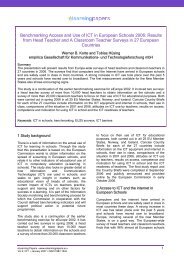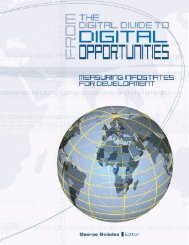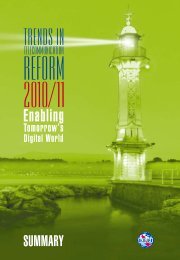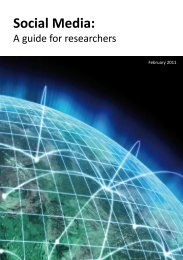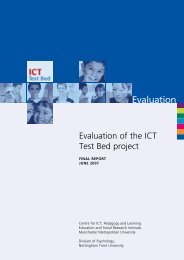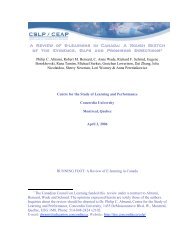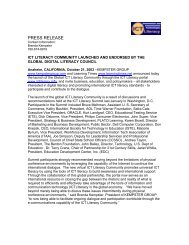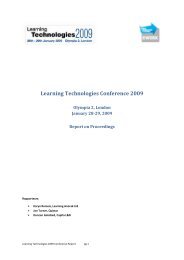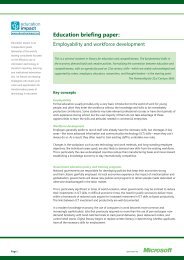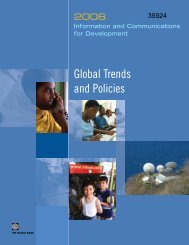Using ICT for Quality in Teaching- Learning Evaluation Processes
Using ICT for Quality in Teaching- Learning Evaluation Processes
Using ICT for Quality in Teaching- Learning Evaluation Processes
Create successful ePaper yourself
Turn your PDF publications into a flip-book with our unique Google optimized e-Paper software.
<strong>Us<strong>in</strong>g</strong> <strong>ICT</strong> <strong>for</strong> <strong>Quality</strong> <strong>in</strong> Teach<strong>in</strong>g- Learn<strong>in</strong>g<br />
<strong>Evaluation</strong> <strong>Processes</strong><br />
By Ms Jillian Dellit, Director, Learn<strong>in</strong>g Federation Secretariat<br />
Australian Education Systems Officials Committee<br />
Adelaide, South Australia<br />
Abstract<br />
<strong>ICT</strong> does not automatically add quality. There is however, grow<strong>in</strong>g<br />
evidence that <strong>ICT</strong> application to the core bus<strong>in</strong>ess of education can<br />
accelerate and improve learn<strong>in</strong>g on a number of fronts. It can also<br />
provide the means of gather<strong>in</strong>g, connect<strong>in</strong>g and analys<strong>in</strong>g data about<br />
teach<strong>in</strong>g and learn<strong>in</strong>g <strong>in</strong> ways that enable us to more accurately<br />
diagnose student need and evaluate programs. To apply <strong>ICT</strong> <strong>in</strong> these<br />
ways requires changed approaches by educators.<br />
This paper looks at the contribution that <strong>ICT</strong> can make to quality <strong>in</strong><br />
teach<strong>in</strong>g, learn<strong>in</strong>g and evaluation through improvements <strong>in</strong> cognition,<br />
pedagogies, convergence, culture, and data.<br />
Introduction <strong>ICT</strong> does not automatically add quality to teach<strong>in</strong>g and learn<strong>in</strong>g. It is<br />
possible to use <strong>in</strong><strong>for</strong>mation and communication technologies <strong>for</strong> trivial<br />
purposes, to waste students’ time with <strong>in</strong><strong>for</strong>mation and communication<br />
technology or even worse, to use <strong>in</strong><strong>for</strong>mation and communications<br />
technology <strong>for</strong> destructive or immoral purposes. We can certa<strong>in</strong>ly use <strong>ICT</strong><br />
to further entrench <strong>in</strong>equalities and to favour particular groups. There is<br />
evidence <strong>in</strong> the USA, <strong>for</strong> example, that African American and Hispanic<br />
students are given more repetitive drill and practice tasks on computers and<br />
fewer sophisticated simulation applications than their white peers<br />
[Wegl<strong>in</strong>sky 1998; Kreuger 2000].<br />
There is however, grow<strong>in</strong>g evidence that <strong>ICT</strong> application to the core<br />
bus<strong>in</strong>ess of education can accelerate and improve learn<strong>in</strong>g on a number of<br />
fronts, from basic skills (Mann 1999; BECTA 2000); problem solv<strong>in</strong>g (Oliver<br />
and Omari 1999; Williams 1999), <strong>in</strong><strong>for</strong>mation management (Peabody 1996),<br />
work habits (Adnanes 1998), motivation (US Congress 1995; Allen<br />
2000;Combs 2000;Diggs, 1997; Sherry, 2001), establish<strong>in</strong>g life-long<br />
learn<strong>in</strong>g habits (Schollie 2001) and concepts development (Yelland 1998).<br />
In addition, <strong>in</strong><strong>for</strong>mation and communication technologies are be<strong>in</strong>g applied<br />
to the management of learn<strong>in</strong>g and to the bus<strong>in</strong>ess models of educational<br />
delivery. One recent report that evidences this trend is the USA based,<br />
Year Four CEO Forum School Technology and Read<strong>in</strong>ess Report [CEO<br />
Forum 2001]. This report l<strong>in</strong>ks assessment and accountability with access,<br />
analysis and most importantly, alignment. These concepts will be discussed<br />
later <strong>in</strong> the paper.<br />
56 ! <strong>Us<strong>in</strong>g</strong> <strong>ICT</strong> <strong>for</strong> Teach<strong>in</strong>g, Learn<strong>in</strong>g and Management
Educators there<strong>for</strong>e have a choice. We can push the boundaries of<br />
<strong>in</strong><strong>for</strong>mation and communications technology <strong>in</strong> education, seek<strong>in</strong>g to exploit<br />
its capacities to improve our outcomes by extend<strong>in</strong>g us beyond the limits and<br />
paradigms we currently experience or we can limit it to the boundaries that<br />
we currently know, challeng<strong>in</strong>g only our technical skills. If the teach<strong>in</strong>g<br />
profession and ma<strong>in</strong>stream educational <strong>in</strong>stitutions follow this path we will be<br />
overtaken by newer, more commercial models of <strong>ICT</strong> enabled education.<br />
Ignor<strong>in</strong>g it is not an option at all.<br />
This paper looks at the contribution that <strong>ICT</strong> can make to quality <strong>in</strong> teach<strong>in</strong>g,<br />
learn<strong>in</strong>g and evaluation through improvements <strong>in</strong> cognition, pedagogies,<br />
convergence, culture, and data.<br />
There are several levels on which <strong>ICT</strong>s can push the cognition boundaries.<br />
New media allow us to represent <strong>in</strong> rich and diverse ways. This is not simply<br />
a matter of learn<strong>in</strong>g styles although diverse learn<strong>in</strong>g styles can be supported<br />
by <strong>ICT</strong>. New media enable us to traverse the boundaries of art, science,<br />
language and senses. They allow us to represent and simulate experience.<br />
<strong>ICT</strong> allows us to accelerate or decelerate processes <strong>for</strong> purposes of<br />
understand<strong>in</strong>g. Just as an experiment allows us to reproduce, represent or<br />
test a pattern of activity <strong>in</strong> the physical world, multimedia allows us to<br />
represent and experiment <strong>in</strong> a ‘virtual’ world – transferr<strong>in</strong>g control and<br />
concept to the learner <strong>in</strong> new ways. We can improve safety, <strong>for</strong> example,<br />
us<strong>in</strong>g technology (the difference between a flight simulator and learn<strong>in</strong>g <strong>in</strong><br />
the air) so that the concepts are transferred, confidence is built through<br />
simulated experience and skills are developed, long be<strong>for</strong>e the risk has to be<br />
taken.<br />
Eliot Eisner (1998:105)) claims:<br />
Everyone knows what a culture is – it is a place <strong>for</strong> grow<strong>in</strong>g th<strong>in</strong>gs, and<br />
schools are places <strong>for</strong> grow<strong>in</strong>g m<strong>in</strong>ds (Cole1985). The curricula we offer and<br />
the teach<strong>in</strong>g methods we employ are means <strong>for</strong> creat<strong>in</strong>g m<strong>in</strong>ds. It is <strong>in</strong> this<br />
sense that the curriculum is a m<strong>in</strong>d-alter<strong>in</strong>g device (Bernste<strong>in</strong> 1971) and the<br />
school a culture of grow<strong>in</strong>g m<strong>in</strong>ds. As this conception of m<strong>in</strong>d takes root <strong>in</strong><br />
our conceptual life, it creates an optimism <strong>for</strong> education <strong>for</strong> it emphasises the<br />
possibilities of school<strong>in</strong>g, its capacity to make a difference <strong>in</strong> the k<strong>in</strong>d of<br />
m<strong>in</strong>ds that students can come to own.<br />
The best cognitive understand<strong>in</strong>gs and practice can be captured and<br />
communicated by <strong>ICT</strong>s and applied to the task of grow<strong>in</strong>g m<strong>in</strong>ds <strong>in</strong> ways that<br />
improve the quality of learn<strong>in</strong>g <strong>for</strong> many, rather than few children. <strong>ICT</strong>s can<br />
give teachers access to great conceptualisers – <strong>in</strong>side and outside their own<br />
ranks – to assist them <strong>in</strong> plann<strong>in</strong>g and programm<strong>in</strong>g cognitive development.<br />
Best of all, the <strong>in</strong>teractive capacity of <strong>ICT</strong>s provides more opportunities <strong>for</strong><br />
students to engage as creators and manipulators <strong>in</strong> the learn<strong>in</strong>g process.<br />
<strong>ICT</strong>s support us <strong>in</strong> br<strong>in</strong>g<strong>in</strong>g together aesthetic as well as scientific<br />
considerations, allow<strong>in</strong>g us to overlay knowledge and mean<strong>in</strong>g with skill and<br />
competence. We can, <strong>for</strong> example, enable students to design <strong>in</strong> ways that<br />
demonstrate perspectives difficult to create <strong>in</strong> classroom spaces, that reveal<br />
Cognition<br />
<strong>Us<strong>in</strong>g</strong> <strong>ICT</strong> <strong>for</strong> Teach<strong>in</strong>g, Learn<strong>in</strong>g and Management " 57
new ways of see<strong>in</strong>g; we can br<strong>in</strong>g serious research more easily <strong>in</strong>to creative<br />
writ<strong>in</strong>g or we can <strong>in</strong>corporate story treatments <strong>in</strong>to science us<strong>in</strong>g multi-media<br />
to enrich and stimulate better learn<strong>in</strong>g outcomes (Williams 1999).<br />
Bra<strong>in</strong> research now available to all teachers with an Internet connection<br />
enables us to stimulate specific bra<strong>in</strong> s – and to be more targeted <strong>in</strong> our<br />
ef<strong>for</strong>ts to stimulate cognition <strong>in</strong> <strong>in</strong>dividual students.<br />
We can, <strong>in</strong> short, use <strong>ICT</strong>s to qualitatively improve cognition by<br />
conceptualis<strong>in</strong>g more creatively, improv<strong>in</strong>g teachers’ knowledge and by<br />
tailor<strong>in</strong>g learn<strong>in</strong>g resources to meet the particular needs of a child at every<br />
stage of his or her education.<br />
Pedagogies It has been widely recognised that harness<strong>in</strong>g the power of modern<br />
technologies <strong>for</strong> learn<strong>in</strong>g purposes requires that appropriate learn<strong>in</strong>g<br />
strategies be developed that harmonise effectiveness <strong>in</strong> learn<strong>in</strong>g with the<br />
technology role. This recognition underp<strong>in</strong>s the UfI/National Grid <strong>for</strong> Learn<strong>in</strong>g<br />
relationship, and a general <strong>in</strong>terest <strong>in</strong> foster<strong>in</strong>g <strong>in</strong>novation <strong>in</strong> learn<strong>in</strong>g<br />
strategies (Kearns & Papadopoulos 2000:77).<br />
<strong>ICT</strong>s provide many opportunities to more easily use a variety of pedagogies.<br />
As a tool, <strong>ICT</strong>s can support didactic or facilitative approaches, collaboration<br />
and <strong>in</strong>teraction across time and distance, enquiry or <strong>in</strong>terrogation, open or<br />
closed research, lock step or m<strong>in</strong>d-map. Onl<strong>in</strong>e technologies support and<br />
make easier constructivist approaches, just as they make behaviourist<br />
approaches easier. The capacity of <strong>ICT</strong> to deliver <strong>in</strong><strong>for</strong>mation or to<br />
communicate with a mass of students <strong>in</strong> quite <strong>in</strong>dividual ways opens up the<br />
possibility of tailor<strong>in</strong>g pedagogy to the needs of a student <strong>in</strong> time and place<br />
without the limitations imposed by peer groups. This provides the opportunity<br />
<strong>for</strong> software that utilises, <strong>for</strong> example, multiple <strong>in</strong>telligence theory.<br />
While it is true that:<br />
In<strong>for</strong>mation technology can only contribute substantially to the improvement<br />
of school<strong>in</strong>g if it is appropriately embedded <strong>in</strong> powerful and <strong>in</strong>teractive<br />
learn<strong>in</strong>g environments [established with<strong>in</strong>] the broader context of [supportive]<br />
pedagogy, curriculum and school organisation (DEETYA 1996:14), when it is<br />
so embedded, the improvement could be substantial. <strong>ICT</strong>s, <strong>for</strong> example, lend<br />
themselves very readily to holistic learn<strong>in</strong>g, collaborative group<strong>in</strong>g, problemoriented<br />
activities and <strong>in</strong>tegrated thematic units. Teachers wish<strong>in</strong>g to teach <strong>in</strong><br />
this way will be both more efficient and effective if they employ <strong>ICT</strong>s to reach<br />
their goals. The <strong>ICT</strong>s of themselves will not improve pedagogy. They will,<br />
however, support and assist teachers who shift their pedagogies to be more<br />
student-d, project-based and collaborative. Scaffold<strong>in</strong>g techniques are readily<br />
supported by <strong>ICT</strong>s. Systems, pr<strong>in</strong>cipals and teacher tra<strong>in</strong><strong>in</strong>g <strong>in</strong>stitutions can<br />
use <strong>ICT</strong> to drive <strong>in</strong> these directions, us<strong>in</strong>g it to provide the scaffold<strong>in</strong>g <strong>for</strong> the<br />
teacher as the teacher does <strong>for</strong> the student.<br />
58 ! <strong>Us<strong>in</strong>g</strong> <strong>ICT</strong> <strong>for</strong> Teach<strong>in</strong>g, Learn<strong>in</strong>g and Management
We are experienc<strong>in</strong>g convergence on many fronts (Wise 1999, 248),<br />
fuelled by <strong>in</strong><strong>for</strong>mation and communications technologies. Technologies<br />
themselves are converg<strong>in</strong>g. Medical technologies are converg<strong>in</strong>g with<br />
educational technologies (<strong>for</strong> example, the application of bra<strong>in</strong> scann<strong>in</strong>g<br />
to educational purposes, of chemical impact on the bra<strong>in</strong> to behaviour<br />
modification) onl<strong>in</strong>e technologies are converg<strong>in</strong>g with offl<strong>in</strong>e technologies<br />
(through, <strong>for</strong> example, the use of XML), digital technologies are<br />
<strong>in</strong>teract<strong>in</strong>g with media, with publish<strong>in</strong>g <strong>in</strong>dustries, with enterta<strong>in</strong>ment,<br />
distribution and production <strong>in</strong>dustries. Such convergence has profound<br />
implications <strong>for</strong> the organisation, management and conception of<br />
education and educational delivery.<br />
Further, as Dias and Atk<strong>in</strong>son (2001:8)) po<strong>in</strong>t out:<br />
Research <strong>in</strong>dicates that some of the most <strong>in</strong>terest<strong>in</strong>g and <strong>in</strong>novative uses<br />
of technology take place <strong>in</strong> classrooms where multiple uses of technology<br />
are implemented.<br />
Inevitably, convergence is also occurr<strong>in</strong>g with<strong>in</strong> the curriculum, across<br />
traditional subject areas, most of which were classified (and thereby<br />
conceptualised) <strong>in</strong> the eighteenth and n<strong>in</strong>eteenth centuries. In the last<br />
thirty years new subjects have been added to curricula – subjects such as<br />
media studies, ecology, comput<strong>in</strong>g studies, creative writ<strong>in</strong>g,<br />
environmental studies. As useful as these subjects might be, the<br />
cont<strong>in</strong>ual addition of areas of study to timetables and the already crowded<br />
curriculum will not serve as a useful model <strong>for</strong> the future. In the end, if we<br />
are to achieve quality outcomes <strong>for</strong> the students of the future, we must<br />
use <strong>ICT</strong>s to assist us to manage the convergence.<br />
Multiskill<strong>in</strong>g is one response. Knowledge management, us<strong>in</strong>g the<br />
organis<strong>in</strong>g capacity of digital technology is another. Alignment is another.<br />
Multiskill<strong>in</strong>g seeks to layer skills over knowledge areas, construct<strong>in</strong>g a<br />
matrix that br<strong>in</strong>gs together, at the po<strong>in</strong>t of an educational outcome, both<br />
subject knowledge and discipl<strong>in</strong>e, with other skills or competencies (such<br />
as problem-solv<strong>in</strong>g, <strong>in</strong><strong>for</strong>mation technology skill, high level literacy skill or<br />
team skills). Multiskill<strong>in</strong>g places high demands on teachers, who must<br />
themselves be multiskilled <strong>in</strong> order to manage the multiskill<strong>in</strong>g demands<br />
of a curriculum. In<strong>for</strong>mation and communication technologies play a<br />
significant part <strong>in</strong> multiskill<strong>in</strong>g because they provide enabl<strong>in</strong>g tools to<br />
speed processes and l<strong>in</strong>k knowledge.<br />
Knowledge management br<strong>in</strong>gs search eng<strong>in</strong>es, thesauri, ‘see also’ and<br />
‘see’ algorithms to l<strong>in</strong>k data-bases, texts, graphics, <strong>for</strong>mulae and logic<br />
trees that by-pass the ‘silos’ of traditional subject th<strong>in</strong>k<strong>in</strong>g – assist<strong>in</strong>g<br />
students <strong>in</strong> mak<strong>in</strong>g connections across many areas of study and creat<strong>in</strong>g<br />
new doma<strong>in</strong>s of knowledge specifically <strong>for</strong> groups of students. Digital<br />
curriculum content can be built to capture some of this convergence. This<br />
is illustrated <strong>in</strong> the appended matrix <strong>for</strong> productions by the Sydney-based<br />
Open Tra<strong>in</strong><strong>in</strong>g Education Network – Distance Education (OTEN-DE) of a<br />
prototype Physics Unit (Dobbs 2001).<br />
Convergence<br />
Responses to<br />
convergence<br />
<strong>Us<strong>in</strong>g</strong> <strong>ICT</strong> <strong>for</strong> Teach<strong>in</strong>g, Learn<strong>in</strong>g and Management " 59
Convergence is a significant opportunity and challenge <strong>for</strong> educators. We must<br />
meet the challenge and f<strong>in</strong>d <strong>ICT</strong> applications to assist us <strong>in</strong> manag<strong>in</strong>g<br />
convergence more effectively than we have <strong>in</strong> the past because the world itself<br />
is convergent as well as divergent; we need to educate <strong>for</strong> both.<br />
Alignment Alignment is an emerg<strong>in</strong>g concept <strong>in</strong> education facilitated by <strong>in</strong><strong>for</strong>mation and<br />
communication technology.<br />
Schools can only be effective <strong>in</strong> enhanc<strong>in</strong>g teach<strong>in</strong>g, learn<strong>in</strong>g and help<strong>in</strong>g<br />
students achieve well-def<strong>in</strong>ed educational objectives when the standards,<br />
objectives, teach<strong>in</strong>g, curriculum, resources, technology use and assess-ment<br />
are all aligned. The content and methods of assessment must be aligned to<br />
measure standards and objectives. Technology provides valuable tools to<br />
align the system to promote student learn<strong>in</strong>g by provid<strong>in</strong>g a means to monitor<br />
alignment and communicate these <strong>in</strong>itiatives to the public (CEO Forum<br />
2001:13).<br />
This records the conscious application of a bus<strong>in</strong>ess model to education.<br />
Certa<strong>in</strong>ly, <strong>in</strong> the past we have sought consistency <strong>in</strong> education. We have<br />
allocated resources accord<strong>in</strong>g to priorities and we have sought to have Maths<br />
teachers ensure, <strong>for</strong> example, spell<strong>in</strong>g with<strong>in</strong> their subject area rather than<br />
expect<strong>in</strong>g a mother-tongue language teacher to ensure mathematics words are<br />
spelled properly. The emerg<strong>in</strong>g notion of alignment, however, does more than<br />
this. It does more because technology now provides the tools to enable us to<br />
more precisely align, and to measure the extent and quality of that alignment.<br />
In a recent visit to the USA, the author observed the Oklahoma VISION project,<br />
<strong>in</strong>itiated by the State of Oklahoma <strong>in</strong> partnership with Intel, Dell, Microsoft and<br />
a number of content providers. At the moment teachers <strong>in</strong> Oklahoma are<br />
restricted <strong>in</strong> what they teach by the available and approved textbooks. This<br />
project seeks to return responsibility and accountability to teachers <strong>for</strong> how<br />
learn<strong>in</strong>g is achieved. It also br<strong>in</strong>gs content producers <strong>in</strong>to the accountability<br />
framework.<br />
Western Heights, the <strong>in</strong>itiat<strong>in</strong>g district, <strong>in</strong> Oklahoma, is look<strong>in</strong>g <strong>for</strong>:<br />
! disaggregated content that can be matched to specific topics <strong>in</strong> the<br />
curriculum;<br />
! flexibility <strong>for</strong> teachers to choose what works <strong>for</strong> specific curriculum topics<br />
and groups of students;<br />
! payment on the basis of what is used;<br />
! the capacity to alter content use <strong>in</strong> response to test results;<br />
! the capacity to change teach<strong>in</strong>g methodology <strong>in</strong> response to test results;<br />
! the capacity to l<strong>in</strong>k content use to a range of other data about students,<br />
teachers and the learn<strong>in</strong>g process <strong>in</strong> order to analyse data, diagnose need,<br />
restructure programs and redirect resources<br />
! the capacity to allocate fund<strong>in</strong>g to the level of the teacher on a daily basis<br />
<strong>in</strong> response to diagnostic data.<br />
60 ! <strong>Us<strong>in</strong>g</strong> <strong>ICT</strong> <strong>for</strong> Teach<strong>in</strong>g, Learn<strong>in</strong>g and Management
In other words, Western Heights District Oklahoma is seek<strong>in</strong>g the alignment of<br />
their curriculum, their documented outcomes, the content teachers use to<br />
achieve those outcomes, test results, methodology, student data, teacher<br />
professional development and f<strong>in</strong>ance. This amounts to a new bus<strong>in</strong>ess model<br />
<strong>for</strong> education and is only possible with the help of very sophisticated <strong>in</strong><strong>for</strong>mation<br />
management systems and electronically delivered content. In order to achieve<br />
this Vision, Oklahoma sought the assistance of a non-profit company, Jes & Co<br />
who specialise <strong>in</strong> match<strong>in</strong>g <strong>in</strong>teroperable, standards-based solutions to<br />
adm<strong>in</strong>istrative and academic requirements <strong>for</strong> technology from schools. Jes &<br />
Co are develop<strong>in</strong>g a non-proprietary Learn<strong>in</strong>g Management System (Jes & Co<br />
2001) that allows the free exchange of data between different education<br />
functions.<br />
The Australian based Le@rn<strong>in</strong>g Federation (2001) <strong>in</strong>itiative to develop a critical<br />
mass of high quality onl<strong>in</strong>e curriculum content <strong>for</strong> Australian schools faces<br />
similar challenges to the Oklahoma project. At the moment our challenge is to<br />
align sufficient technology standards to allow us to exchange learn<strong>in</strong>g objects<br />
based onl<strong>in</strong>e curriculum content between states and deliver to the school level<br />
<strong>in</strong> a way that protects <strong>in</strong>tellectual property rights and allows teachers to<br />
construct their own learn<strong>in</strong>g sequences. A ‘learn<strong>in</strong>g object’ is a component of<br />
onl<strong>in</strong>e material that can be identified, tracked, referenced, used and reused <strong>for</strong> a<br />
variety of learn<strong>in</strong>g purposes. For example, a learn<strong>in</strong>g object could be a s<strong>in</strong>gle<br />
file such as an animation, a video clip, a discrete piece of text or URL or it could<br />
be a collection of contextual files that make up a complete learn<strong>in</strong>g sequence<br />
(Le@rn<strong>in</strong>g Federation 2001b). The learn<strong>in</strong>g object is likely to be larger than a<br />
digital object – it is a unit that has an educational purpose. Key to the Initiative<br />
is the expectation that, although the curriculum content is designed <strong>in</strong><br />
sequenced units of work, teachers will unpack, re-sequence and comb<strong>in</strong>e<br />
components with other materials of their own. It is Lego-like content, designed<br />
to fit the culture of resource borrow<strong>in</strong>g, creation and comb<strong>in</strong>ation amongst<br />
Australian teachers. We are; however, acutely aware that quality does only<br />
reside <strong>in</strong> the learn<strong>in</strong>g object itself, but <strong>in</strong> its pedagogical surrounds and <strong>in</strong> the<br />
teacher’s capacity to easily l<strong>in</strong>k content with outcomes, with assessment data<br />
and with student profile <strong>in</strong><strong>for</strong>mation. The quality of the alignment as well as that<br />
of the object and he delivery will determ<strong>in</strong>e effectiveness. At the school level,<br />
alignment has always been an issue. In the digital world, however, we can<br />
provide teachers with the tools to access and manipulate data, br<strong>in</strong>g<strong>in</strong>g effective<br />
alignment with<strong>in</strong> reach.<br />
It is difficult to imag<strong>in</strong>e a more potent lever <strong>for</strong> chang<strong>in</strong>g the priorities of schools than the<br />
evaluative methods we employ. What we count counts. What we measure matters. What<br />
we test, we teach….<br />
Data<br />
The promise of new paradigms resides <strong>in</strong> their potential to provide methods and<br />
approaches that are both more equitable and closer to the values practitioners cherish<br />
Eisner (1998:109).<br />
<strong>Us<strong>in</strong>g</strong> <strong>ICT</strong> <strong>for</strong> Teach<strong>in</strong>g, Learn<strong>in</strong>g and Management " 61
If we are to use <strong>ICT</strong> to better achieve the quality of educational outcome that<br />
we want; if we are to maximise cognition, skills development and improve our<br />
outcomes through alignment, we need to <strong>in</strong>crease our respect <strong>for</strong> data. The<br />
debate about test<strong>in</strong>g that has occupied education <strong>in</strong> the school<strong>in</strong>g sector <strong>in</strong><br />
much of the English-speak<strong>in</strong>g world <strong>for</strong> the last decade has obscured he<br />
importance of reliable, valid data to the improvement of educational outcomes<br />
and the <strong>in</strong>creased effectiveness and professionalism that teachers can<br />
access by us<strong>in</strong>g <strong>ICT</strong>s to manipulate data, create <strong>in</strong>telligence and measure<br />
their effectiveness <strong>in</strong> sophisticated ways. Assessment Boards and<br />
accredit<strong>in</strong>g agencies <strong>in</strong> Australia, <strong>for</strong> example, statistically moderate<br />
exam<strong>in</strong>ation scores aga<strong>in</strong>st teacher-based school assessments over many<br />
years. At a school level, with <strong>in</strong>terfac<strong>in</strong>g databases it would be possible over<br />
time to identify methodologies, motivational approaches, resources, activities,<br />
strategies that impact on outcomes. We don’t have to rely on externally<br />
imposed tests <strong>in</strong> order to extract better value from data and evidence.<br />
Joe Kitchens, the District Super<strong>in</strong>tendent <strong>in</strong> Western Heights District <strong>in</strong><br />
Oklahoma has been able to identify that a significant number of students<br />
fail<strong>in</strong>g <strong>in</strong> State maths tests demonstrated poor understand<strong>in</strong>g of Set Theory 1 .<br />
Further exam<strong>in</strong>ation revealed these students had mostly been taught <strong>in</strong> a<br />
similar way. By compar<strong>in</strong>g this with the way successful students had been<br />
taught and retra<strong>in</strong><strong>in</strong>g the teachers of the fail<strong>in</strong>g students, Western Heights<br />
was able to turn the results around.<br />
Australian educators are encultured to be sceptical of the reliance of USA<br />
educators on test results and textbook delivery. However, the po<strong>in</strong>t rema<strong>in</strong>s<br />
very powerful. <strong>ICT</strong>s give us the efficiency to analyse per<strong>for</strong>mance data –<br />
however derived – to identify key po<strong>in</strong>ts of success or problem (that is, to<br />
diagnose), to compare and to <strong>in</strong>tervene. To fail to use the technology <strong>for</strong> this<br />
purpose is to choose ignorance over enlightenment.<br />
To take advantage of this capacity of <strong>ICT</strong>s to assist us <strong>in</strong> evaluation we will<br />
need to develop a more research-oriented culture <strong>in</strong> teach<strong>in</strong>g. Garv<strong>in</strong>’s<br />
comments (2000:218) apply to teachers as well as pr<strong>in</strong>cipals and educational<br />
adm<strong>in</strong>istrators:<br />
All of us are flawed statisticians, who commit a wide range of<br />
<strong>in</strong>terpretative errors. We have trouble separat<strong>in</strong>g signals from noise, do<br />
a poor job estimat<strong>in</strong>g probabilities, rely on mislead<strong>in</strong>g rules of thumb,<br />
and are over-certa<strong>in</strong> of our own understand<strong>in</strong>g and skills. To combat<br />
these errors and improve the accuracy and quality of learn<strong>in</strong>g, experts<br />
use a variety of techniques that could be easily adopted by managers.<br />
They keep runn<strong>in</strong>g lists of their predictions to overcome h<strong>in</strong>dsight<br />
biases. They solicit critical feedback to combat overconfidence. They<br />
review flawed choices to uncover hidden assumptions. They enlist the<br />
help of coaches and third-party observers to ensure that their words<br />
match their deeds. They compile extensive experience banks to enrich<br />
their repertoire of<br />
___________________<br />
1. In conversation with the author, September 2001.<br />
62 ! <strong>Us<strong>in</strong>g</strong> <strong>ICT</strong> <strong>for</strong> Teach<strong>in</strong>g, Learn<strong>in</strong>g and Management
analogies and <strong>in</strong>crease their skill at pattern recognition. They use <strong>for</strong>mal<br />
decision aids to calibrate their judgements and improve consistency. All<br />
of these techniques are designed to heighten awareness and develop a<br />
more ref<strong>in</strong>ed understand<strong>in</strong>g of how decisions are actually made.<br />
We need teachers who are attuned to data and its <strong>in</strong>terpretation. We need<br />
systems that aggregate the right th<strong>in</strong>gs and that make it easy <strong>for</strong> teachers to<br />
record their observations. We need more diagnostic specialists <strong>in</strong> education<br />
as well as more identification of teachers who are good conceptualisers and<br />
multi-media communicators. These are new specialists. <strong>ICT</strong>s open up much<br />
the same opportunities <strong>in</strong> education as medical technologies opened <strong>in</strong> the<br />
health <strong>in</strong>dustry over the last 50 years – and they will demand a similar set of<br />
specialisations. The other factor required to ensure the quality of education<br />
improves with <strong>ICT</strong> application is the tra<strong>in</strong><strong>in</strong>g and quality of teachers and related<br />
professionals <strong>in</strong> the creation, use and <strong>in</strong>terpretation of data and applications<br />
generated from use of those <strong>ICT</strong>s (Oliver 2001).<br />
Education is an <strong>in</strong><strong>for</strong>mation and communications based <strong>in</strong>dustry and <strong>ICT</strong>s give<br />
us the ‘grunt’ to achieve better outcomes. As well as allow<strong>in</strong>g us to<br />
communicate better with our students, and to provide them with more and<br />
better <strong>in</strong><strong>for</strong>mation, they give us better <strong>in</strong><strong>for</strong>mation about our craft and<br />
communicate f<strong>in</strong>er-gra<strong>in</strong>ed <strong>in</strong>telligence more quickly. We need to be prepared<br />
to respond.<br />
I do not believe we will ever create the k<strong>in</strong>d of algorithms that are useful <strong>in</strong><br />
treat<strong>in</strong>g quantitatively rendered data, but we have learned that there is more<br />
than one way to parse reality, and, with more ref<strong>in</strong>ed approaches <strong>for</strong><br />
describ<strong>in</strong>g, <strong>in</strong>terpret<strong>in</strong>g, and apprais<strong>in</strong>g the educational words we care about,<br />
greater confidence <strong>in</strong> methods that elude the security of rule will, I believe,<br />
develop (Eisner 1998:108).<br />
F<strong>in</strong>ally, it is important to view our use of and assumptions about <strong>ICT</strong>s through<br />
a lens of culture. The Delores Report made a couple of predictions about<br />
onl<strong>in</strong>e content and <strong>in</strong><strong>for</strong>mation technology use.<br />
Culture<br />
It seems that the differences will be chiefly between societies that will be<br />
capable of produc<strong>in</strong>g the content and those that will merely receive the<br />
<strong>in</strong><strong>for</strong>mation without tak<strong>in</strong>g a real part <strong>in</strong> the exchanges (Delores 1996:65).<br />
There is no doubt but that <strong>in</strong>dividuals’ ability to access and process <strong>in</strong><strong>for</strong>mation<br />
is set to become the determ<strong>in</strong><strong>in</strong>g factor <strong>in</strong> their <strong>in</strong>tegration not only <strong>in</strong>to the<br />
work<strong>in</strong>g environment but also <strong>in</strong>to their social and cultural environment<br />
(Delores 1996:172).<br />
This paper began by stat<strong>in</strong>g that <strong>ICT</strong>s do not have to be used to educationally<br />
liberat<strong>in</strong>g, or even moral, ends. It is fitt<strong>in</strong>g it conclude with a further rem<strong>in</strong>der<br />
of the obvious. <strong>ICT</strong>s do not have to privilege one culture over another.<br />
Educators almost universally use the book as a tool, adapt<strong>in</strong>g it to the needs of<br />
particular cultures. We need also to use <strong>ICT</strong>s universally <strong>in</strong> education, without<br />
adopt<strong>in</strong>g the economic and cultural assumptions that have driven its rapid<br />
globalization.<br />
<strong>Us<strong>in</strong>g</strong> <strong>ICT</strong> <strong>for</strong> Teach<strong>in</strong>g, Learn<strong>in</strong>g and Management " 63
<strong>Quality</strong> and evaluation are culturally determ<strong>in</strong>ed. The Delores Report and<br />
its reception has demonstrated that there are <strong>in</strong>ternationally shared values<br />
amongst educators. <strong>Quality</strong> <strong>in</strong> education, however, also depends on<br />
specific local application, on meet<strong>in</strong>g the needs of specific <strong>in</strong>dividuals <strong>in</strong><br />
specific social and cultural sett<strong>in</strong>gs, respect<strong>in</strong>g specific cultural values and<br />
communities. As we take up the use of <strong>ICT</strong>s <strong>in</strong> education we need to<br />
exercise care that we respect and make room <strong>for</strong> cultural values and<br />
differences. The standards that enable convergence and alignment and<br />
conceptualisation must also protect and nurture divergence. <strong>Quality</strong> is not<br />
served by hegemony or monoculture.<br />
Applied with <strong>in</strong>telligence, diligence, research and commitment, <strong>ICT</strong>s provide<br />
powerful means of improv<strong>in</strong>g the quality of education along with significantly<br />
improved data <strong>for</strong> diagnosis and <strong>for</strong>mative evaluation. This potential will be<br />
realised if educators <strong>in</strong> all sectors take up the challenge and hard work of<br />
adaptation and change required if we are to develop both <strong>ICT</strong>s <strong>in</strong> education<br />
and the profession <strong>in</strong> its use of them.<br />
References Adnanes M and Ronn<strong>in</strong>g W M (1998). Computer-networks <strong>in</strong> education: a<br />
better way to learn? Journal of Computer Assisted Learn<strong>in</strong>g, 14 (2),<br />
148-157.<br />
Allen A and A<strong>in</strong>ley M (2000). Issues of engagement: the learner's<br />
experience of computers <strong>in</strong> the classroom,. Melbourne, ACER 2000.<br />
BECTA (2000). A prelim<strong>in</strong>ary report <strong>for</strong> the DfEE on the relationship<br />
between <strong>ICT</strong> and primary school standards, British Educational<br />
Communications and Technology Agency, London, October 2000.<br />
Bennett S and Lockyer (1999). The impact of digital technologies on<br />
teach<strong>in</strong>g and learn<strong>in</strong>g <strong>in</strong> K-12 education: a research and literature<br />
review, Curriculum Corporation, Melbourne http://socci.edna.edu.au/<br />
content/phase1.asp<br />
CEO Forum (2001). Key Build<strong>in</strong>g Blocks <strong>for</strong> Student Achievement <strong>in</strong> the<br />
21 st Century: Assessment, Alignment, Accountability, Access, Analysis,<br />
School Technology and Read<strong>in</strong>ess Report 2001, Wash<strong>in</strong>gton.<br />
Combs (2000). Assess<strong>in</strong>g the role of educational technology <strong>in</strong> the teach<strong>in</strong>g<br />
and learn<strong>in</strong>g process: a learner-d perspective, The Secretary's<br />
Conference on Educational Technology 2000, Department of Education,<br />
USA, Wash<strong>in</strong>gton DC. www.ed.gov/<br />
Technology/techconf/2000/mccombs_paper.html<br />
DEETYA (1996). Gateways: In<strong>for</strong>mation technology <strong>in</strong> the learn<strong>in</strong>g process,<br />
Canberra.<br />
Delores J (1996). Learn<strong>in</strong>g: the treasure with<strong>in</strong>. Report to UNESCO of the<br />
International Commission on Education <strong>for</strong> the Twenty-First Century<br />
UNESCO 1998.<br />
64 ! <strong>Us<strong>in</strong>g</strong> <strong>ICT</strong> <strong>for</strong> Teach<strong>in</strong>g, Learn<strong>in</strong>g and Management
Dias L B and Atk<strong>in</strong>son S (2001) Technology <strong>in</strong>tegration: best practice – Where<br />
do teachers stand? International Electronic Journal <strong>for</strong> Leadership <strong>in</strong><br />
Learn<strong>in</strong>g 5 (10) July 1002 http://www.ucalgary.ca/<br />
~iejll/volumes/dias.html<br />
Diggs C S. (1997). Technology: a key to unlock<strong>in</strong>g at-risk students. Learn<strong>in</strong>g<br />
and Lead<strong>in</strong>g with Technology, 25 (2), 38-40.<br />
Dobbs G (2001). Learn<strong>in</strong>g Resources <strong>for</strong> the e-learn<strong>in</strong>g era, unpublished paper,<br />
OTEN-DE Sydney.<br />
Eisner, E W (1998) The k<strong>in</strong>d of schools we need He<strong>in</strong>emann, Portsmouth NH.<br />
Garv<strong>in</strong> D A (2000) Learn<strong>in</strong>g <strong>in</strong> action: a guide to putt<strong>in</strong>g the learn<strong>in</strong>g<br />
organization to work, Boston MA, Harvard Bus<strong>in</strong>ess School Press.<br />
Jes and Co (2001). www.jessandco.org.<br />
Kearns P & Papadopoulos G (2000). Build<strong>in</strong>g a learn<strong>in</strong>g and tra<strong>in</strong><strong>in</strong>g culture: the<br />
experience of five OECD countries, NCVER, Adelaide.<br />
Kreuger A B (2000). The digital divide <strong>in</strong> educat<strong>in</strong>g African-American Students<br />
and Workers, Work<strong>in</strong>g paper 434, Industrial Relations Section, Pr<strong>in</strong>ceton<br />
University, March 2000, www.irs.pr<strong>in</strong>ceton.edu/pubs/<br />
work<strong>in</strong>g_papers.html<br />
Le@rn<strong>in</strong>g Federation (2001a). http://socci.edna.edu.au<br />
Le@rn<strong>in</strong>g Federation (2001b). http://socci.edna.edu.au/content/pdf/phase2<br />
plan.pdf<br />
Mann, D et al; (1999). West Virg<strong>in</strong>ia story: achievement ga<strong>in</strong>s from a statewide<br />
comprehensive <strong>in</strong>structional technology program, Milken Exchange,<br />
www.milkenexchange.org<br />
McRea D (2001). What to make and why: Pr<strong>in</strong>ciples <strong>for</strong> the design and<br />
development of onl<strong>in</strong>e curriculum content, Curriculum Corporation,<br />
Melbourne http://socci.edna.edu.au/content/phase1.asp<br />
Meredyth D et al (1999). Real time: computers, change and school<strong>in</strong>g, DETYA,<br />
Canberra.<br />
Oliver R (2001). Assur<strong>in</strong>g the quality of onl<strong>in</strong>e learn<strong>in</strong>g <strong>in</strong> Australian Higher<br />
Education, Mov<strong>in</strong>g Onl<strong>in</strong>e Conference Gold Coast Queensland,<br />
2-4 September 2001 www.scu.edu.au/schools/sawd/moconf/MOC2-<br />
papers2001/oliver.pdf<br />
Oliver R and Omari A. (1999). <strong>Us<strong>in</strong>g</strong> onl<strong>in</strong>e technologies to support problem<br />
based learn<strong>in</strong>g: learners responses and perceptions Australian Journal of<br />
Educational Technology 15 (1) Autumn 1999, 58-79.<br />
Peabody M A (1996). The role of onl<strong>in</strong>e communications <strong>in</strong> schools: a national<br />
study, <strong>for</strong> Applied Special Technology (CAST).<br />
Schollie B (2001). Student Achievement and Per<strong>for</strong>mance Levels <strong>in</strong> Onl<strong>in</strong>e<br />
Education Research Study, Alberta Onl<strong>in</strong>e Consortium, Edmonton,<br />
www.albertaonl<strong>in</strong>e.ab.ca<br />
<strong>Us<strong>in</strong>g</strong> <strong>ICT</strong> <strong>for</strong> Teach<strong>in</strong>g, Learn<strong>in</strong>g and Management " 65
Sherry L et al (2001). Assess<strong>in</strong>g the Impact of Instructional Technology on<br />
Student Achievement, T.H.E February 2001, <strong>for</strong> Internet Technology<br />
<strong>in</strong> Education Conference 2001, http://www.thejournal.<br />
com/magaz<strong>in</strong>e/vault/A3297.cfm<br />
US Congress, Office of Technology Assessment (1995). Teachers and<br />
technology: mak<strong>in</strong>g the connection. Wash<strong>in</strong>gton, DC, Government<br />
Pr<strong>in</strong>t<strong>in</strong>g Office.<br />
Wegl<strong>in</strong>sky H (1998). Does it compute? The relationship between<br />
education technology and student achievement <strong>in</strong> mathematics Policy<br />
In<strong>for</strong>mation , Educational Test<strong>in</strong>g Service USA 1998.<br />
Williams DC (1999). The effect of expert stories on sixth grade student<br />
achievement and problem-solv<strong>in</strong>g <strong>in</strong> hypermedia supported-authentic<br />
learn<strong>in</strong>g environments (HALE) Proceed<strong>in</strong>gs of ED-MEDIA/ED-<br />
TELECOM 99 World Conference on Educational Media and Hypermedia<br />
and World Conference on Educational Telecommunications<br />
p112-118, Charlotteville VA Association <strong>for</strong> the Advancement of<br />
Comput<strong>in</strong>g <strong>in</strong> Education.<br />
Wise P and Russell G (1999). Convergence, <strong>in</strong><strong>for</strong>mation technology and<br />
curriculum <strong>in</strong> Meredith D et al (1999) Real time: computers, change<br />
and school<strong>in</strong>g, DETYA, Canberra p245.<br />
Yelland (1998). Empowerment and control with technology <strong>in</strong> the early<br />
childhood years, Educational Practice and Theory, 20 (2) 45-55.<br />
66 ! <strong>Us<strong>in</strong>g</strong> <strong>ICT</strong> <strong>for</strong> Teach<strong>in</strong>g, Learn<strong>in</strong>g and Management



